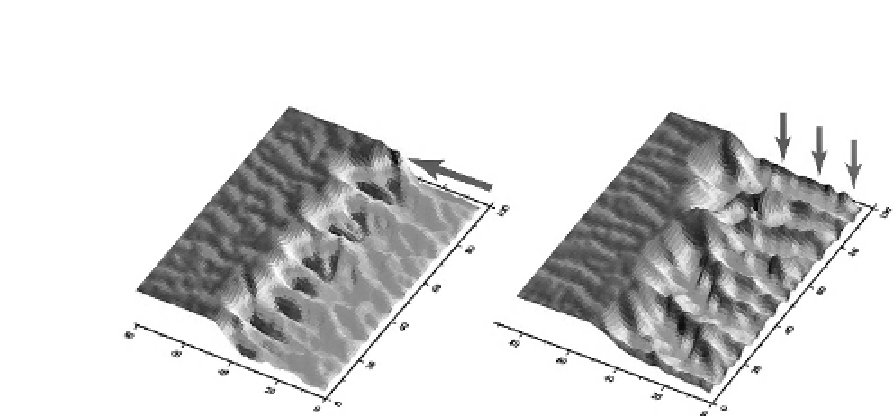Geology Reference
In-Depth Information
Modeled Patterns of Cooling Ages
Escarpment
retreat
Escarpment
degradation
Young
cooling ages
Young
cooling ages
0
50
100
150
He age (Ma)
Fig. 11.28
Modeling the generic thermal evolution of an eroding escarpment.
A. Modeled topographic evolution of an escarpment in which geomorphic rules lead to escarpment retreat,
and associated predictions of the field of He ages. B. Modeled topographic evolution of an escarpment in which
geomorphic rules lead to escarpment degradation, and associated predictions of the field of He ages. Note that the
patterns of cooling ages are significantly different when retreat, rather than downwearing, dominates. Modified from
Braun and van der Beek (2004). [A color version of this appears as Plate 12.]
the differences in closure ages for two or more
chronometers in a single sample are predictable.
At a minimum, even these simple steady
models must, therefore, address the following
list of thermal aspects of the problem: thermal
conduction and potential spatial variations in
the thermal diffusivity of the rocks; the role of
radiogenic heat production in the rocks, which
again can be spatially variable (for example, a
silicic pluton embedded in sedimentary rocks);
and surface temperature boundary conditions,
which will vary with elevation.
But many geological and geomorphic situations
of interest in mountainous landscapes are not
steady, and the advection of heat can be very
complex (see Fig. 11.27). In these cases, we must
abandon simple models for the more complex. In
models capturing these cases, the thermal
algorithms (and the physics they are meant to
portray) are the same, but are played out on a
two-dimensional grid. One such model is called
Pecube (Braun, 2003, 2005). The complexity lies
largely in driving the spatial distribution of
surface elevation change - in effect, one must
marry a landscape evolution model with a
thermal model, and deal with the complexity
in both systems. Imagine a model in which the
model landscape evolves over millions of years,
the final landscape perfectly representing the
present-day topography. One could then chose
any pixel from the model and assess the thermal
history of the rock that emerges on the surface at
that point. This history could then be compared
with thermochronometric data, and the misfit
between the data and the model predictions can
be calculated. Effectively, each model is then
given a score. After many models are run, one
chooses the one yielding the best score (lowest
misfit between model and data).
In Fig. 11.28 and Plate 12, we illustrate the
application of this strategy to the evolution of a
major escarpment (Braun and van der Beek,
2004). Here the question is whether the
escarpment evolves by backwearing, which is
equivalent to horizontal motion of the scarp, by
downwearing, or by some combination of the
two. Models of generic escarpments that have
evolved with these two end-member styles,











































